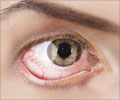Gender, age and place of stay play role in glaucoma risk, shows study.

"Although many studies from around the world have reported on the burden of the disease, some aspects of the basic descriptive epidemiologic features, which may help shed light on the cause, are inconsistent," said Louis Pasquale, M.D., study co-author and director of Massachusetts Eye and Ear's Glaucoma Center of Excellence.
"In this study we found that women are more vulnerable to this disease than men, that ES is not a disease of Norwegian descent, and that where you live does matter when it comes to developing the disease."
Researchers from the Mass. Eye and Ear, Harvard Medical School, Boston, Mass., Department of Medicine, Channing Laboratory, Brigham and Women's Hospital, Boston, Mass., Department of Ophthalmology and Visual Sciences, and University of Michigan, Ann Arbor, Mich., set out to find out how demographic and geographic risk factors are associated with ES.
They used data from 78,955 women in the Nurses' Health Study (NHS) and 41,191 men in the Health Professionals Follow-up Study (HPFS) residing throughout the continental United States who were prospectively followed for 20 years or more and who provided lifetime residence information to examine the descriptive epidemiologic features of ES or exfoliation glaucoma suspect (EGS).
This study confirmed established associations with age and family history and exfoliation glaucoma or exfoliation glaucoma suspect (EG/EGS), as well as provided new data on associations with gender, eye colour and ancestry.
Advertisement
The study showed an increased risk in females, but it was unclear as if gender-specific differences in the eye, such as axial length differences or environmental factors related to lifestyle, account for why women are more at risk for this disease.
Advertisement
Source-ANI












